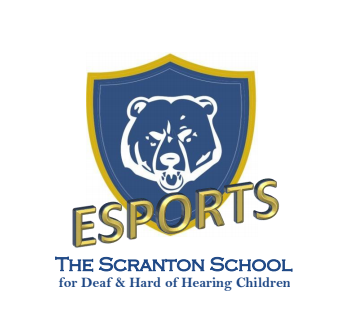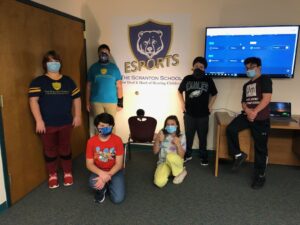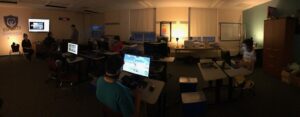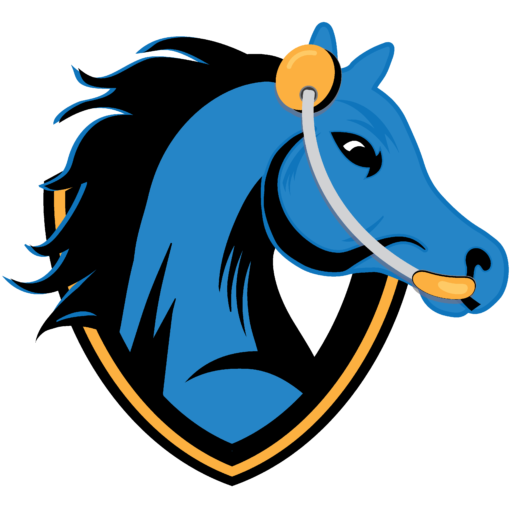
What Esports For All Looks Like
Esports?
I read the text from my Director with a bit of surprise:
“What do you think about adding esports to our program? Check it out – I think this might be what we are looking for.”
Despite my initial skepticism (I’m a traditionalist when it comes to sports – and as a Coach, Athletic Director and sports Official of nearly 20 years, the initial mental shift of esports being a sport was hard for me) we jumped into action researching what it would take to get a program running on our campus.
First up was finding a league or program designed for middle school students to learn how to get started. While several programs for high school students seemed to be readily available, only one search result came back with a league that also has middle school teams – Garden State Esports. After our initial research was complete, a few emails were exchanged and a single phone conversation with Chris Aviles convinced us that this really was a viable option for our students. It quickly became evident that Chris is not only a champion of and pioneer for esports as a legitimate school-based team, he was committed to the principles of inclusion and fairness for all. I mean, we aren’t even located in New Jersey.
Esports for All
 The Scranton School for Deaf and Hard of Hearing Children, located in South Abington Township, in Northeastern Pennsylvania, serves children with hearing loss from age 3 through 8th grade. We prepare children who are Deaf, deaf, hard of hearing, or have other communication needs for all aspects of life through high-quality, student-centered education and extracurricular programs in an all All-Inclusive Communication Environment. We believe that every one of our students has the potential to succeed in the world, and that it is our privilege to provide them with every possible opportunity and the necessary supports to help them reach their full potential. Our CEO and Board, in fulfillment of that mission, have for many years been highly committed to the integration of technology and STEAM in our classrooms – and they required very little convincing to support this new endeavor. With their enthusiastic blessing, we pushed ahead with determining the space, hardware, and accessories that would be needed to implement our esports program for our kids.
The Scranton School for Deaf and Hard of Hearing Children, located in South Abington Township, in Northeastern Pennsylvania, serves children with hearing loss from age 3 through 8th grade. We prepare children who are Deaf, deaf, hard of hearing, or have other communication needs for all aspects of life through high-quality, student-centered education and extracurricular programs in an all All-Inclusive Communication Environment. We believe that every one of our students has the potential to succeed in the world, and that it is our privilege to provide them with every possible opportunity and the necessary supports to help them reach their full potential. Our CEO and Board, in fulfillment of that mission, have for many years been highly committed to the integration of technology and STEAM in our classrooms – and they required very little convincing to support this new endeavor. With their enthusiastic blessing, we pushed ahead with determining the space, hardware, and accessories that would be needed to implement our esports program for our kids.
A tour of the weeks-old esports arena at Misericordia University helped us envision our own practice and competition space and clued us in to some of the issues that we would need to address in the coming roll-out.
We did many of the typical things an esports team would do when getting started. Our Technology Director and IT team customized our PCs, we designed a team logo to accessorize the room, and bought a large flat-screen television for watching match play and video reviews. Running an esports team for deaf and hard of hearing students, though, requires extra consideration.
Typically, players without hearing loss communicate via headset or, in a team room, by direct voice communication without taking their eyes off the screen. Every effort was made to enhance the visual accessibility of language and communication for our students. A 45” High Definition television serves as a great teaching and match observation tool. Purchase of 29” monitors helped to make participation accessible and level the playing field during practice and match play for students who have vision challenges. We also place a coach or teammate nearby to relay messages to/from teammates to facilitate communication.
We set up our computers so students could communicate using American Sign Language (ASL) directly with one another – simply arranging the monitors in a semi-circle allowed for line-of-sight interaction between our players during dynamic game play with minimal detraction from the on-screen action However, for students participating from home, several additional hurdles had to be overcome.
Ambient lighting in the team room presented another issue – it was quickly apparent that fluorescent overhead lights, while good for team discussion and blackboard sessions, were not going to cut it during game play. When students glanced up to communicate with teammates and coaches, and then back at their game screens, there was a brief delay as their eyes adjusted to the room lighting from the screen, and vice versa. To address this, we applied the Marine Corps’ unofficial slogan of improvise, adapt, overcome – a few desk lamps strategically placed in the room and pointing at the wall and ceiling provided indirect backlighting when the fluorescent lighting was turned off. This resolved the eye adjustment time while keeping the room safe to move throughout the walkway areas. As we look forward to future upgrades, strategic placement of LED strips behind tables and under shelving should make for a more appealing and uniform appearance in the room with the additional color options creating both excitement and comfort for our players.
COVID Puts Us On Pause
In early March, as schools across the country faced the dynamics of connecting with students remotely due to COVID-19, we were just beginning to understand the interplay between players and were, like most educators, a little overwhelmed at the prospect of adding yet another screen-based activity. Frankly, we were concerned about the amount of screen time that was being required of our students during class time, and wanted to be sure that we did not add an additional burden to parents to ensure that students were “on time” for practices and matches outside of our regular classroom hours. So, we hit the pause button just before launching our team in March of 2020. In hindsight, the greatest benefit of this was that it allowed our coaching staff to acquire a broader awareness of the dynamics and layers involved in an esports program. In turn, this awareness enabled us to be better prepared for a more robust rollout of the program, including Social and Emotional Learning (SEL) components, development of student leadership, and networking strategies.
With the suspension of athletic programming for fall sports and the potential for limited traditional athletics in the immediate future, our administration made the decision to further invest in our esports program by reallocating funding that had initially been earmarked for athletic programs in the annual budget. This reallocation and investment in the program allowed us to make significant upgrades to existing hardware and equipment that will leave us well-prepared for expansion as we look forward to a return to in-person instruction. This reallocation of funds is an investment in the STEAM capabilities of our lab, and makes even more high-quality computers available for student use across our campus.

Game on!
The pause in implementation also helped us to realize that the addition of an experienced former player/coach would be an incredible asset to our students and allowed us some time to add a capable coach to our staff.
For the past few years our school has been offering American Sign Language classes to local community business partners. Some of these businesses have offered employment readiness experiences and community based vocational training for our students. When two of the attendees of one of these classes learned of our fledgling esports program, they inquired about how they might get involved. The timing was perfect and we could not be more pleased with the results of adding an experienced IT pro and Gaming aficionado to our coaching team!
In addition to the typical challenges of setting up a new program and getting all of the hardware and internal procedures ironed out, working out communication strategies and systems for our team was one of our major concerns. How do we facilitate direct communication during dynamic play from home? Initially, our program launched while we were in an in-person instructional model for most of our students. Just prior to the Thanksgiving holiday, the pandemic responses and guidance dictated by various authorities meant a rapid change in our instructional model to a fully virtual model. Enter Google Classrooms. With a few small tweaks to how we have implemented the esports classroom, we found that the student’s familiarity with this structure provided almost identical results to those of being in-person in the STEAM lab on campus. The tools within the Google classroom allow us to post practice and match information, diagrams, videos and other instructional tools for easy access by our players. The video-conferencing tool, with the optional Closed Captioning in addition to good quality video is just right for supporting the inclusivity that we require when it comes to communication.
I would be remiss not to mention Chris Aviles and the rest of the Garden State Esports League for the incredible resource and support that they have been in launching this program. The enthusiastic attitudes, implementation advice, and technical support that we have received from everyone in this community have been inspiring. The passion that these folks have for using this medium to impact and empower students is absolutely contagious. The league has been designed to provide maximum participation for every student in a fun and competitive environment – truly reflecting what school-based sports should look like in my opinion.
Early Outcomes:
Seven months after first launching our esports team and one pandemic later, we played our first-ever match against Williams Area Middle School on November 11th. Our CEO, Dr. Steven Farmer made sure that he could be on hand to observe all the components of Game Day in person. Dr. Farmer was intrigued by the process and the excitement of the competition and thrilled by our initial progress. He immediately recognized the accessibility and potential of Esports for all students with hearing loss. He asked us to begin to consider how we can replicate our success on the campus of our Middle School and High School programs at The Western Pennsylvania School for the Deaf, in Pittsburgh, PA – and to also begin to explore how we could share what we have learned and accomplished across the national Deaf Education Community.
The positive impact of this endeavor in the first few weeks has been significant. Students lacking in confidence have begun to demonstrate leadership skills and self-assuredness, taking initiative within the esports context, offering technical and strategic advice and guidance to teammates. For other students, we have seen more consistent attendance and an increase in classroom engagement. Core class attendance/participation is required in order to be part of virtual and in-person practices and matches. This seems to have had a motivating impact on some students to develop more consistent engagement within their core courses. Within our team, our coaches are capitalizing on this intrinsic motivation by intentionally focusing on the development of those essential “soft skills” of time management and personal responsibility. Students have begun to hold each other accountable for classroom attendance, assignment completion and practice participation – and are receptive to the motivational comments of their teammates.
This program has also fostered a new opportunity for social development for our students – giving them a common starting point around which to interact with each other outside of school. For some, it has also given them confidence to reach out to hearing peers within the gaming community. Stories of interactive play and new friendships made over the weekend are beginning to surface as skill levels and confidence continue to increase.
Conclusion:
The esports team at the Scranton School for Deaf and Hard of Hearing Children is definitely a work in progress – with much to learn in this invigorating new adventure. Our students have benefited from the support of our administration, the creative reallocation of physical and financial resources, and the welcoming environment of Garden State Esports as we have rolled out our program. Our students, coaches, and school community have found this an exciting endeavor around which to rally and support our players. More importantly, this endeavor is proving that school-based esports are a valid strategy for providing relevant engagement to students from all walks of life, regardless of whether they are Deaf or Hearing. The Scranton School for Deaf and Hard of Hearing Children is proud to be a pioneering partner with Garden State Esports in this field as we look forward to developing life-long benefits and relationships for our students and so many others.
Now that we have a few games under our belt, our next mission is to work with Garden State Esports to imagine what streaming and casting our games would look like for our deaf community! What can I say – this one-time skeptic has become a true believer in the accessibility, relevance, and benefits of esports for all!
~Doug Boersma
Coach, Scranton Bears
